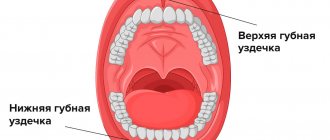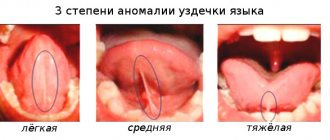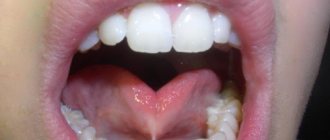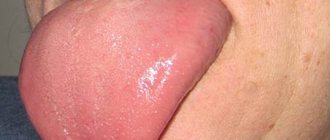Human papillomavirus (HPV, HPV) belongs to the group of papillomaviruses and is one of the most common sexually transmitted diseases. This infection was already known in ancient Greece; Hippocrates himself studied one of the types of HPV - condylomas and gave them the name “genital warts”.
HPV is a virus that is transmitted only from person to person. Currently, about 600 types of HPV are known, some varieties can cause the growth of benign or malignant tumors.
HPV types:
- HPV, which manifests itself as warts (HPV 1-5): warts (calluses) located on the soles of the feet - HPV types 1-4;
- flat warts - HPV types 3, 10, 28, 49;
- common warts - HPV type 27.
1
Diagnosis of papillomavirus infection
2 Diagnosis of human papillomavirus infection
3 Diagnosis of human papillomavirus infection
How is the operation performed?
Preparation for such a surgical intervention comes down to thorough sanitation of the oral cavity, because any infection in it can provoke complications. It is necessary to undergo an examination to ensure that there are no contraindications to such an intervention.
This operation does not require special preparation, since the procedure is low-traumatic. Before performing it, doctors advise patients to be full, because such an intervention is less tolerated on an empty stomach, and hunger is an additional stress, which causes the blood to clot more slowly.
One of the important conditions for performing an operation in childhood is to ensure that the little patient sits quietly in a chair for at least 10-15 minutes. The procedure does not cause discomfort and is absolutely painless; during the procedure, the baby can sit with his mouth slightly open, and is even able to talk.
HPV. Symptoms
The papilloma virus is constantly present in a person’s blood, but is activated only when immunity decreases. With weakened immunity, HPV begins to accumulate on the skin or mucous membrane and leads to the appearance of tumors.
At a young age, HPV manifests itself as warts that are located on the fingers, elbows, and knees. Then a papilloma grows on a person’s skin (a soft-to-the-touch round formation on a stalk, with the help of which the papilloma is attached to the skin). Most often, papillomas are located on the skin of the face, neck, armpits, and papillomas are also found on the labia.
One of the most common manifestations of HPV is condyloma (uneven to the touch, soft, attached to the body with a stalk or a wide base, grows quite quickly, sometimes in a few hours).
Thus, warts, papillomas and condylomas are different signs of the same papillomavirus infection. Papilloma is a benign formation that can “show off” on a person’s face and body, not too pleasing to him aesthetically, but without causing much harm. Unlike papilloma formations, human condyloma tends to inflame and damage the skin and mucous membranes.
Condylomas
Condylomas are formations on the skin of the genitals, on the pubis, inner thighs, in the urethra, around the anus (anal condylomas) and inside the anus, having a lobed structure, flesh-pink in color, pedunculated or with a wide base, from a few millimeters to ten centimeters (eg, giant Buschke-Levenshtein condylomas).
Condylomas usually come in 2 types:
- condyloma lata, wide neoplasms with a wide base with which they attach to the skin, these neoplasms are considered a sign of secondary syphilis;
- genital warts, similar to soft pinkish bubbles with a thin stalk.
Condylomas acuminata
Genital warts are small flesh-colored formations that choose the genitals and anus as their location. In appearance, condylomas are sometimes confused with pearlescent papules, which are not a disease. Unlike pearlescent papules, genital warts are soft to the touch, attached to a thin stalk, and can be of different sizes.
Pointed papillomas are transmitted only sexually (through all types of sexual contact), therefore they belong to the group of sexually transmitted infections.
Causes of condyloma
There are various reasons for the appearance of condyloma, among which there are several main ones:
- having multiple sexual partners;
- long incubation period (time from infection to clinical manifestations);
- complex diagnostics;
- the presence of many types of PVI viruses;
- combination with other sexually transmitted infections;
- lack of protection effect using condoms from infection, etc.
1 Urethroscopy for diagnosing HPV
2 Urethroscopy for diagnosing HPV
3 Urethroscopy for diagnosing HPV
Abnormalities of attachment of the frenulum of the lips and tongue
One of the preventive measures aimed at the timely prevention of dental diseases is the correction of the frenulum of the lips and tongue. When examining children, a pediatric dentist often reveals abnormalities in the attachment of the frenulum, which must be promptly corrected. The frenulum of the lips and tongue is an important component of the normal development of the dental system. They are folds of the mucosa, which are normally located along the midline and provide additional attachment of the lips and tongue to the jaw bones. A lot can depend on them: correct speech and bite, the ability to chew normally, the aesthetics of the face and smile, as well as the timely development of both jaws.
Tongue frenulum
The frenulum of the tongue starts from the middle of the tongue and goes down almost to the base of the gums. If the end of the frenulum is close to the tip of the tongue, then they speak of a “short” frenulum. At the same time, such a frenulum limits the movement of the tongue. The child cannot fully suckle at the mother's breast, which leads to lack of nutrition and, as a consequence, a significant lag in the baby's growth and development. At the age of 0 to 6 months, the incision is made by pediatricians and dentists without any anesthesia, the operation does not require sutures, and the wound heals within a few days thanks to breast milk.
Often, a shortened frenulum in children aged 5-9 years causes incorrect pronunciation of certain sounds, usually palatal ones: “r”, “d”, “l”. It is difficult for a child to touch the tip of his tongue to the upper incisors and simply stick out his tongue. And the speech therapist refers the child to a plastic surgeon. At the moment, there are several options for performing the operation. The most common is dissection of the frenulum lengthwise under local or general anesthesia, followed by suturing. An alternative to traditional surgery may be laser excision of the frenulum. This manipulation does not require sutures, due to the fact that the wound is covered with fibrin plaque and does not bleed. This is a very important circumstance, since large lingual veins are located nearby.
Lip frenulum
Most often, orthodontists, periodontists and speech therapists refer for plastic surgery of the upper lip frenulum. The fact is that the frenulum of the upper lip is often woven into the interdental papilla, between the central incisors, and sometimes into the incisive papilla, leading to an increase in the gap between the front teeth - the formation of a diastema. In addition, the shortened frenulum, when moving the upper lip, pulls along the mucous membrane of the alveolar process of the upper or lower jaw - as a result of this, the gums expose the necks of the incisors, causing their hypersensitivity, exposure of the roots, and periodontal disease in older people. And in children, during the period of formation of a permanent bite, a shortened frenulum of the upper lip can lead to the advancement of the front teeth forward, especially if there is not enough space in the dentition. Subsequently, such malocclusions are corrected orthodontically. Another complication of a short labial frenulum is a speech impediment. The child pronounces some sounds “u” and “o” poorly.
The surgery is performed under local anesthesia. The main point is to cut the frenulum lengthwise and apply sutures. The stitches are removed after 5-7 days. Modern methods of dental surgery make it possible to perform frenuloplasty without pain and blood. The frenuloplasty operation is performed using a laser device. Laser frenuloplasty lasts only a few minutes, does not require sutures, and never leads to the development of postoperative complications such as inflammation or swelling. In addition, laser plastic surgery does not cause severe pain in the child, and therefore is performed without serious anesthesia (applying a small amount of anesthetic gel to the frenulum is sufficient).
Doctor Ivanov K.A.
St. Petersburg State Budgetary Healthcare Institution "Dental Clinic No. 6".
HPV in women
HPV in women manifests itself not only as papillomas on the body, but also causes the development of cervical erosion , precancerous conditions, and cervical cancer . Condyloma in women is quite difficult to detect; it can exist in a woman’s body for a long time without any symptoms, and is discovered purely by chance at an appointment with a gynecologist. That’s why it’s so important to visit a specialist regularly, once every six months!
Symptoms of condyloma include:
- genital warts, which can appear on the genitals (condyloma on the labia, vaginal condyloma, cervical condyloma), in the oral cavity, on the skin of the anus (anal condyloma);
- disturbance in the maturation of epithelial cells (there are 3 stages of the process, the third stage is precancer);
- the development of a malignant formation from the epithelium lining the cervix.
When is lip frenuloplasty required?
The pathology of the labial frenulum does not always indicate that the patient requires surgery. Sometimes it is minor and does not cause any particular inconvenience. As a rule, surgery is necessary in the following cases.
- Diastema.
The excess gap between the central incisors tends to widen, causing the teeth to move forward and move apart in different directions. Also, constant stress on the gums leads to periodontitis. - Orthodontic treatment.
Correcting the bite with braces requires that the frenulum be of the correct shape and have an anatomical location. Therefore, before starting treatment, the orthodontist often sends the patient for plastic surgery. - Periodontal diseases.
A short frenulum can expose the roots of the teeth. - Complete prosthetics.
A short frenulum does not allow a removable denture to be firmly and securely fastened. This is one of the most common cases when plastic surgery of the lower lip frenulum is performed in adults.
Photo of a short frenulum of the upper lip in a child.
Development of the disease
HPV infection can occur through all types of sexual contact (vaginal, oral, rectal), while condoms are not a guarantee of protection, since condylomas can be localized on unprotected areas of the skin and the size of the virus is smaller than the pore size of condoms. In addition, the virus can also be transmitted to the baby during childbirth if the woman is a carrier of the virus.
The human papillomavirus (HPV) has a tropism for the skin and mucous membranes of the genitals, oral cavity, and anus. The amount of virus depends on the state of both the immune system as a whole and local immunity. The more productive the individual factors of the immune system are, the more actively the division of the virus is blocked, and the less of it is contained. That is, a person can be infected with HPV without having any external clinical symptoms.
Diagnostic methods
How can a tongue tie be diagnosed in infants? Parents can easily recognize this defect on their own. The baby’s tongue is tightly attached to the lower jaw, its movements are limited (mobility directly depends on the severity of the anomaly), the child is not able to stick his tongue out of his mouth. By lifting the baby's tongue, you can see the connective tissue thread that attaches the tongue to the oral cavity.
This diagnosis can be easily recognized during breastfeeding. For such babies, the feeding process takes a longer time, since the baby is not able to grasp the nipple normally. Therefore, the sucking process is difficult and intermittent. Because of this, these babies gain weight slowly and become restless before feeding.
In older children, such a pathology as a short frenulum is expressed by a violation of word formation and a lisp - it is difficult for them to pronounce the sounds sh, shch, h, zh, r.
Clinical picture
Condylomata acuminata are formations of flesh-pink color, lobulated, ranging in size from 2 millimeters to ten centimeters, with exophytic growth, in which the apex of the genital condyloma is often wider than the base. Externally, the growths may resemble cauliflower or cockscomb.
The incubation period can range from 2-3 months to 2-3 years or more. The growth rate of formations varies, which is often associated with the state of local immunity, the presence of concomitant STIs, and sexual activity.
Treatment of a short frenulum of the tongue
In children, treatment of a short frenulum is carried out surgically. Excision of the frenulum is a simple operation with virtually no complications. After this procedure, the child feels well and does not experience any pain.
The decision on the need to trim the frenulum (frenotomy) is made immediately as soon as the baby is born, since bloodless plastic surgery cannot affect the general condition of the newborn. The procedure can be performed directly in the maternity hospital or in the dental office. Babies have few blood vessels and nerve endings, so the doctor does not use anesthesia when making a transverse incision. If there is slight bleeding, it can be easily stopped by applying the baby to the chest. After the operation, the newborn adapts to the new conditions for several days, so the mother will immediately feel the difference during feeding.
If the short frenulum is not corrected in time, the child may develop other developmental pathologies a few years later, such as incorrect dentition, speech defects, etc. If you ignore plastic surgery until the child is 5-6 years old, there may be a need for real surgical intervention, in which Sutures are placed and anesthesia is administered. Trimming the frenulum is carried out with special scissors or a radio wave scalpel. The duration of the procedure is no more than a minute.
Children of primary school age are brought to the surgical office by an orthodontist or speech therapist when the consequences of an untreated short frenulum are too obvious. During the operation, the tongue is released. Separately, uneven teeth and incorrect pronunciation have to be corrected.
In the event that it was not possible to perform plastic surgery in childhood, and a short frenulum of the tongue as a person grows older causes severe discomfort and significantly limits the excursion of the tongue, it is necessary to visit a dentist. The doctor will recommend an operation that can relieve the patient of speech defects and periodontal inflammation in the area of the lower incisors. In both adult patients and adolescents, the operation is performed under general anesthesia, using self-absorbing sutures.
Complication after condylomas
Human condyloma is not just a harmless lobular growth on the genitals, it is a reservoir for the human papillomavirus. In recent years, cases with localization of genital warts in the oral cavity and throat have become more frequent, and there are condylomas on the lips.
The virus, accumulating in tissues, causes a change in the genome of epithelial cells of the skin or mucous membranes, which can lead to the development of severe complications. In men, HPV can lead to penile cancer . HPV in women threatens the development of cervical cancer . With these diseases, HPV is found in almost all patients.
What are the differences between upper and lower lip frenuloplasty?
Although the operations themselves to correct pathology on the upper and lower lips are similar, they require a different approach to rehabilitation. After plastic surgery of the lower lip frenulum, the wound takes longer to heal, about two weeks, while plastic surgery of the upper lip frenulum requires only a few days to recover. In the first case, anti-inflammatory therapy is often prescribed to prevent complications.
Asymptomatic carriage of human papillomavirus (HPV)
In reality, many more people are infected with HPV than statistics show. Most of them simply do not know about it, since there are no symptoms of condyloma.
The virus may not manifest itself in any way for a long time, since the human immune system does not allow it to develop to the required extent. However, at any time, with a decrease in both general and local immunity, this can happen, and then papillomas and/or condylomas appear.
1 Laboratory diagnostics
2 Dermatoscopy
3 Extended colposcopy
Plastic surgery of the frenulum is carried out in several stages:
- frenotomy – the frenulum of the upper lip is dissected;
- frenectomy – excision of the frenulum of the upper lip is performed;
- frenuloplasty – the place where the frenulum is woven is moved to a new depth.
The operation is performed using two methods. Its classic version uses a scalpel. A more modern method is laser surgery. However, despite all the advantages of laser correction, the classical method remains relevant, which is used in our clinic. This is especially true for complex clinical cases, in which the skill of the surgeon is very important. Upper lip plastic surgery is performed on an outpatient basis. The duration of the classic operation is no more than a quarter of an hour, and local anesthesia (injections or gel) is used.
If you retract the lip with a narrow frenulum of the upper lip, it is possible to see a transparent film that is not attached to the edge of the alveolar process. It is cut transversely, then longitudinal sutures are applied.
In the case of a wide frenulum of the upper lip, the doctor makes an incision in the tense frenulum along the ridge, excises the interdental papilla and the tissues of the bone space located between the roots of the central incisors.
Papilloma virus. Diagnostics:
- Consultation with a dermatovenerologist . Only a dermatovenerologist can make a diagnosis during an initial examination, assessing the clinical picture, conducting a test with acetic acid, and, if necessary, using the dermatoscopy method.
- Laboratory diagnostics. It is necessary to conduct a HPV test using the PCR method, which will allow you to estimate the amount of the virus, as well as determine which type of HPV is present in this case (they are divided into types with high and low risk of oncogenicity). A PCR test must also be performed on all sexual partners of a patient with genital warts. A positive test result in the absence of clinical manifestations of the disease means that treatment is necessary to suppress the development of the virus in the body.
- Urethroscopy is a study of the condition of the urethral mucosa using special endourethral endoscopes. Considering the increase in recent years in the number of patients with endourethral condylomas, this study is necessary for all patients, both men and women.
- Extended colposcopy - examination of the cervix using a colposcope and performing a test with acetic acid and the Schiller test. It is necessary for all women to undergo laboratory confirmation of papillomavirus infection, since the presence of flat condylomas on the cervix is possible.
- Immunogram is a study of the state of the immune system. This will allow for the most effective HPV therapy.
Treatment
To the question of how to treat papillomas in intimate places , modern medicine gives a clear answer: they need to be removed. Destruction of benign neoplasms can be carried out using various methods:
- electrocoagulation – exposure to high frequency current;
- cryodestruction - removal using cold treatment;
- laser removal – layer-by-layer treatment with laser radiation;
- chemical destruction - using special chemical solutions.
Classic surgical removal is also an option.
A specific scheme for how to completely and safely remove papillomas in intimate places is prescribed by a specialist in accordance with the localization of the process, the severity of the course, and concomitant diseases.
An important aspect of treating papillomas in intimate places is changing lifestyle and strengthening the immune system. An integrated approach avoids the emergence of new formations.
What operations are used?
Types of labial frenuloplasty:
- Frenulotomy;
- Frenulectomy;
- Frenuloplasty using the Limberg method;
- Fixation with sutures using the Dieffenbach method;
- Correction using laser.
The main type of treatment is surgical. First, the patient is given anesthesia. For children, before the injection, it is recommended to use gels with local anesthetics to numb the injection site. Thus, pain during basic anesthesia is reduced. After a couple of minutes, several injections are made into the frenulum area.
Next, a wedge-shaped incision is made and the attachment is excised. A deep incision is made on the side of the frenulum down to the bone, without touching the gum near the incisors. The resulting area is grabbed with tweezers and cut off. It is best to do this in the area of the papilla, since the level of aesthetics will be higher with this method.
At the end of the manipulation, the edges of the wound are connected to each other and sutures are applied. The patient is prescribed rinsing with antiseptic solutions and the use of healing drugs (for example, solcoseryl). You must return for examination and removal of sutures after 7-10 days.
If desired, the invasiveness of the operation can be reduced using a laser. Anesthesia is carried out using the same technique. The laser is set to pulse mode, power 1 W. Movements during tissue excision should be short and intermittent. Be sure to stretch the fabrics to achieve the best effect.
After the operation, there is no need to apply stitches, since the wound is slightly smaller in size. Instead, a special protective film is applied, which contains keratoplasty.
Recommendations after surgery include: using a toothbrush with soft bristles, rinsing with antiseptic solutions. You can also prescribe antiseptic tablets “Lizobakt” and apply “Solcoseryl” paste to the wound surface.
Contraindications to surgery
It is recommended to postpone lip frenuloplasty in the following cases:
- Diseases of the circulatory system;
- Oncological diseases;
- Stage of infection activity;
- Chronic pathologies that may affect the duration of recovery after surgery on the labial frenulum;
- Diseases of the oral mucosa.
Lip frenuloplasty is not a complicated operation and is easily tolerated even by the smallest children. Quick recovery eliminates any discomfort. After just a couple of days, the child recovers completely. And after 2 weeks, it becomes possible to correct the changes caused by the incorrectly growing frenulum.











